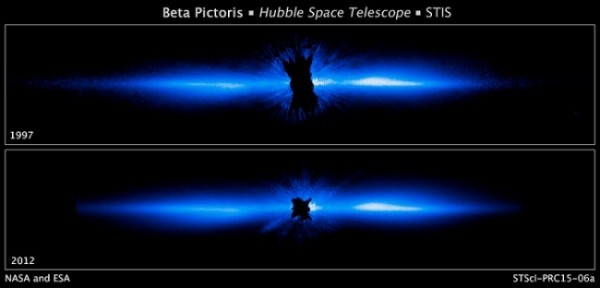Hubble Captures New Images of Young Star Beta Pictoris
| Marco Foronda | | Feb 22, 2015 06:16 AM EST |
(Photo : NASA, ESA, and D. Apai and G. Schneider (University of Arizona)) The photo at the bottom is the most detailed picture to date of a large, edge-on, gas-and-dust disk encircling the 20 million year-old star Beta Pictoris.
NASA's Hubble Space Telescope has captured images of a huge gas-and-dust disk surrounding the 'young' 20 million year-old star, Beta Pictoris. So far, Beta Pictoris (discovered in 2009) is the only debris disk that has a huge planet.
The Beta Pictoris disk consists of a large amount of dust caused by recent collisions among planets and asteroids that have not been detected so far. Daniel Apai from the University of Arizona said a complex structure for the inner disk was predicted by some computer simulations because of gravitational pull by the short-period huge planet.
Like Us on Facebook
"The new images reveal the inner disk and confirm the predicted structures. This finding validates models, which will help us to deduce the presence of other exoplanets in other disks," explained Apai.
The planet, which orbits Beta Pictorous every 18 to 20 years, allows scientists to study in a kind of slow motion how the large planet distorts the gas and dust cloud around its star.
New visible-light Hubble images trace the dust and gas disk to within 650 million miles of the star. The planet orbits at 900 million miles and was imaged by the European Southern Observatory's Very Large Telescope six years ago.
Researchers note the disk appears especially dusty, which could be caused by collisions between planet- and asteroid-sized objects in the disk.
When the James Webb Space Telescope launches in 2018 followed by the European Extremely Large Telescope in 2024, researchers should get an even better view of the processes in action around Beta Pictoris.
TagsHubble Space Telescope, hubble, NASA, Beta Pictoris, Beta Pictoris star, Star, space exploration, debris disk
©2015 Chinatopix All rights reserved. Do not reproduce without permission
EDITOR'S PICKS
-

Did the Trump administration just announce plans for a trade war with ‘hostile’ China and Russia?
-

US Senate passes Taiwan travel bill slammed by China
-

As Yan Sihong’s family grieves, here are other Chinese students who went missing abroad. Some have never been found
-

Beijing blasts Western critics who ‘smear China’ with the term sharp power
-

China Envoy Seeks to Defuse Tensions With U.S. as a Trade War Brews
-

Singapore's Deputy PM Provides Bitcoin Vote of Confidence Amid China's Blanket Bans
-

China warns investors over risks in overseas virtual currency trading
-

Chinese government most trustworthy: survey
-

Kashima Antlers On Course For Back-To-Back Titles
MOST POPULAR
LATEST NEWS
Zhou Yongkang: China's Former Security Chief Sentenced to Life in Prison

China's former Chief of the Ministry of Public Security, Zhou Yongkang, has been given a life sentence after he was found guilty of abusing his office, bribery and deliberately ... Full Article
TRENDING STORY

China Pork Prices Expected to Stabilize As The Supplies Recover

Elephone P9000 Smartphone is now on Sale on Amazon India

There's a Big Chance Cliffhangers Won't Still Be Resolved When Grey's Anatomy Season 13 Returns

Supreme Court Ruled on Samsung vs Apple Dispute for Patent Infringement

Microsoft Surface Pro 5 Rumors and Release Date: What is the Latest?










